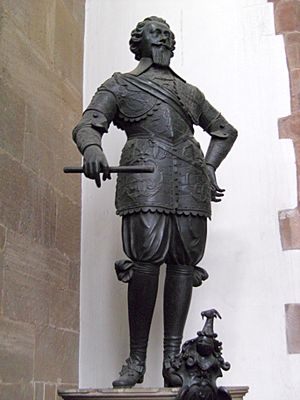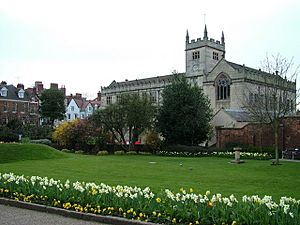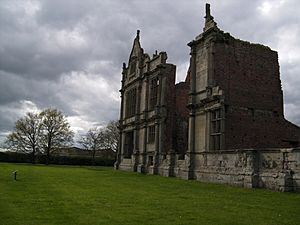Richard Corbet (died 1606) facts for kids
Sir Richard Corbet (born around 1545, died 1606) was an important English gentleman who owned land and was involved in politics during the time of Queen Elizabeth I. This period is often called the Elizabethan period.
Contents
Early Life and Schooling
Richard Corbet was the second son of Sir Andrew Corbet and Jane Needham. His father, Sir Andrew, was a very active and skilled leader. He was part of the Council in the Marches of Wales for 25 years, which was a special group that helped govern Wales and the border areas of England.
The Corbet family had been important in Shropshire since the Norman Conquest (around 1066!). Their main home was Moreton Corbet Castle, which was still a strong place during the Tudor period. During Queen Elizabeth I's reign, the Corbets were leading Protestant families in the county.
Richard was born around 1545. His older brother was Robert. Richard's parents' marriage was arranged by his great-uncle, also named Richard Corbet. This great-uncle had looked after Sir Andrew when he was young. Richard Corbet's parents had four more sons and six daughters after him.
Richard Corbet likely went to Shrewsbury School. This school opened in 1552 and was known for its excellent teachers and students. The Corbet family had many connections to the school. One of Richard's great-uncles, Reginald Corbet, helped start it. The first headmaster, Thomas Ashton, was a friend of Richard's father. Shrewsbury School was a good place for Protestant families to send their sons, like Philip Sidney, whose father was also a friend of the Corbets.
Life as a Landowner
Homes and Money Troubles
As a younger son, Richard Corbet was not expected to inherit all the family's main lands. He married Mary Morgan, who was a widow. She had received property called Clattercote in Oxfordshire from her first husband, which she could use for her lifetime. Richard bought the rights to this property in 1582, so it would become his after Mary died. This might have been their main home for a while.
In 1583, Richard's older brother, Robert Corbet, sadly died from the bubonic plague while visiting London. Since Robert had no sons, Richard became the new head of the family. He inherited many properties in Shropshire and other counties like Bedfordshire and Cornwall.
Richard also inherited Moreton Corbet Castle. His brother Robert had started building a new, fancy Italian-style part of the castle, but it was not finished. Richard tried to complete it, but he couldn't because he was already in debt. It seems Richard lived at nearby Shawbury while the castle was a big building site.
Richard often started expensive projects before finishing others. He was already in debt when he inherited the family lands. Even though the estates were large, he had many expenses and spent too much. For example, his brother's two young daughters needed to be married, and large parts of the family's wealth had to be set aside for their marriages.
Richard tried to make more money in different ways. He often went to court to settle arguments over land, especially with William Watson. Richard's first wife, Mary, had the right to use other properties from her first husband, including the manor of Cropredy. Richard fought hard in court to gain full ownership of Cropredy, which he finally did in his later years.

He also tried investing in businesses, like ironworks. His brother-in-law, Walter Leveson, was in serious financial trouble. In 1591, Richard and his youngest brother, Vincent, leased all of Leveson's ironworks in Shropshire. They hoped this would help pay off Leveson's debts faster. However, this plan didn't work out well, and the Privy Council (a group of royal advisors) made the Corbets take a loan to help Leveson's creditors. Despite his own money problems, Richard was still generous. In the same year, he gave the leaders of Shrewsbury enough deer meat to feed over 100 people!
Keeping Law and Order
Richard Corbet held important positions in Shropshire. He became a Justice of the Peace (J.P.) in 1588, helping to keep law and order. In 1590, he was made a Deputy Lieutenant of the county, and in 1592-93, he served as Sheriff. In 1594, he joined the Council in the Marches of Wales.
Sometimes, Richard's actions were surprising for a gentleman of his standing. In 1589, he and his group attacked the house of a widow named Elizabeth Vernon, took her belongings and animals, and ruined her crops. The Privy Council heard about this and told him it would "deeply touch you in credit" if he didn't fix this "foul disorder."
Richard could also be very strict in enforcing the law. In 1591, he went after Walter Lea, who was known as a "notorious bad and evil disposed person." Lea was a lawyer who had gotten into trouble for large debts and fraud. It's not clear if Richard was pursuing Lea because he was a creditor or simply to enforce the law.
In 1596, during a time when food was scarce, Richard was told by the Privy Council to limit how much grain two alehouses in Market Drayton were using for brewing. They were using a lot of grain, which could have fed many poor people. Richard was ordered to make sure they only brewed what was absolutely necessary and to stop people from drinking too much there.
Despite some of his questionable actions, Richard Corbet was honored by King James I in 1603, becoming a Knight of the Order of the Bath.
Time in Parliament
Richard Corbet was chosen to be a Member of Parliament (MP) for Shropshire in 1586. He was the main representative for the county, along with his brother-in-law, Walter Leveson. The MPs for Shropshire usually came from a small group of important landowning families, and the Corbets had been among them for centuries. There were no elections where people fought for the county seats during Queen Elizabeth's reign.
Parliament met from October 1586 to March 1587. We don't know much about what Richard did in Parliament, but as the first MP for the county, he would have been on the committee that dealt with taxes and money matters.
Later Life and Death
Richard Corbet died in 1606 and was buried at Moreton Corbet. By the time he died, he owed a lot of money – more than £5700!
His will, a legal document about his wishes after death, showed he owed money to many people, including his own sister, Mary. The will was a long list of debts and his attempts to fix them, mixed with some very generous gifts. He gave his second wife, Judith, £300. He was also very generous to his servants, giving some as much as £30. He gave large sums to relatives and friends, like £300 to his nephew Robert and £400 to his niece Mary. He even gave £40 to important people like John Popham, the Lord Chief Justice of England, and Roger Owen, both of whom were very wealthy.
Richard Corbet had no children who lived to inherit from him. However, he was hopeful until the end. In his will, he wrote that if his wife, Judith, had a daughter, he wanted £4000 to be paid to her when she turned 16.
In the end, his brother, Vincent Corbet, inherited his estates. Vincent already had a son, Andrew Corbet, who would continue the family line.
Marriages and Family
Richard Corbet was married twice:
- Mary Wolfe: She was the daughter of Morgan Wolfe and the widow of Thomas Lee. Mary had her own money and property from her first marriage. They did not have any children together. We don't know exactly when she died.
- Judith Austin (1566-1640): She was the daughter of Thomas Austin. Judith had been married twice before marrying Richard. Her first husband was William Boothby, with whom she had two sons and at least one daughter, Elizabeth. Her second husband was William Basset, and they had a daughter, also named Elizabeth.
After William Basset died, his daughter Elizabeth became a "ward" of the Crown, meaning the king or queen would look after her and her property until she was older. Sir Walter Raleigh bought the right to be her guardian. He even planned for her to marry his own son. However, Sir Walter Raleigh later got into trouble with the king. During her short marriage to Richard Corbet, Judith was trying to get her daughter's guardianship back.
Judith was pregnant when Richard Corbet died, but the child either miscarried or died soon after birth. So, Richard Corbet had no children who survived him. However, Judith's daughter from her first marriage, Elizabeth Boothby, later married Richard's nephew, Andrew Corbet (Vincent's son). This meant Judith was still connected to the Corbet family line. Judith lived a long life and was buried at Blore, next to her second husband, William Basset, and their daughter.
Images for kids




